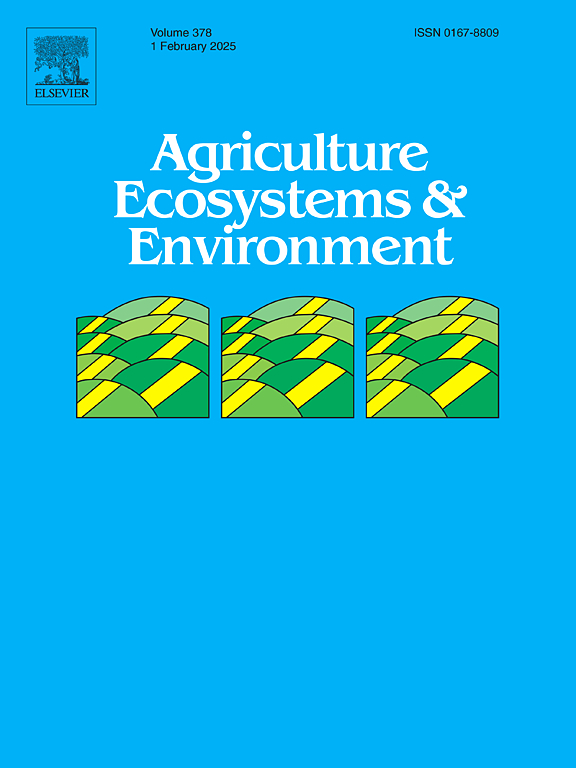Effects of straw returning depth on soil organic carbon sequestration and crop yield in China: A meta-analysis
IF 6
1区 农林科学
Q1 AGRICULTURE, MULTIDISCIPLINARY
引用次数: 0
Abstract
Carbon sequestration is a crucial strategy for mitigating carbon dioxide emissions and addressing global climate change, with straw returning playing a key role in enhancing soil organic carbon (SOC) storage. However, most studies have focused on surface-level straw returning and its impact on topsoil SOC, with limited attention to how different straw returning depths (RD) on SOC stocks (SOCS) in topsoil (0−30 cm) and subsoil (30−60 cm). This study conducted a meta-analysis of 2290 observations from China to evaluate the effects of varying straw returning depths [0 cm (RD0), 0−20 cm (RD0−20), 20−30 cm (RD20−30), and 30−60 cm (RD30−60)] on SOCS in two soil layers and their relationship with crop yield. All straw returning depths significantly improved topsoil and subsoil SOCS and enhanced soil physicochemical properties. RD20−30 showed the strongest effect on topsoil SOCS (14.3 %), whereas RD30−60 had the weakest (5.6 %). Conversely, RD30−60 had the strongest effect on subsoil SOCS (30.3 %), followed by RD20−30 (15.8 %). Crop yield increased under all straw returning depths, with the greatest gains under RD0−20 (11.2 %) and RD20−30 (10.0 %). However, the effectiveness of each depth varied with environmental and management conditions. For example, RD0 increased SOCS the most under straw inputs below 8000 kg·ha–1 and loam soils, while RD0–20 was most effective in single cropping systems, upland regions, clay loam soils, low temperature and precipitation regions, and maize straw returning. RD20–30 proved beneficial in regions with double cropping systems, paddy and paddy-upland soils, high temperatures, rainy regions, and wheat or rice straw returning. These findings offer evidence-based insights to support sustainable straw returning strategies in China’s agricultural systems.
秸秆还田深度对中国土壤有机碳固存和作物产量影响的meta分析
碳固存是缓解二氧化碳排放和应对全球气候变化的重要策略,秸秆还田在提高土壤有机碳储量方面发挥着关键作用。然而,大多数研究都集中在表层秸秆还田及其对表层土壤有机碳的影响上,很少关注不同秸秆还田深度(RD)对表层土壤(0 ~ 30 cm)和底土(30 ~ 60 cm)有机碳储量(SOCS)的影响。本研究对中国2290个观测数据进行了荟萃分析,以评估不同秸秆还土深度[0 cm (RD0)、0−20 cm (RD0−20)、20−30 cm (RD20−30)和30−60 cm (RD30−60)]对两层土壤SOCS的影响及其与作物产量的关系。所有秸秆还田深度均显著改善了表土和底土SOCS,提高了土壤理化性质。RD20−30对表层土壤SOCS的影响最大(14.3 %),RD30−60对表层土壤SOCS的影响最小(5.6% %)。相反,RD30−60对底土SOCS的影响最大(30.3 %),其次是RD20−30(15.8 %)。在所有秸秆还田深度下,作物产量均有提高,其中RD0−20和RD20−30增产最大,分别为11.2 %和10.0 %。然而,每个深度的有效性因环境和管理条件而异。例如,在8000 kg·ha-1以下秸秆投入和壤土条件下,RD0对SOCS的提高效果最大,而在单作、旱地、粘壤土、低温降水区和玉米秸秆还田条件下,RD0 - 20对SOCS的提高效果最大。RD20-30在双熟制、水田和旱田土壤、高温、多雨地区和小麦或水稻秸秆还田的地区具有良好的效果。这些发现为支持中国农业系统的可持续秸秆还田策略提供了基于证据的见解。
本文章由计算机程序翻译,如有差异,请以英文原文为准。
求助全文
约1分钟内获得全文
求助全文
来源期刊

Agriculture, Ecosystems & Environment
环境科学-环境科学
CiteScore
11.70
自引率
9.10%
发文量
392
审稿时长
26 days
期刊介绍:
Agriculture, Ecosystems and Environment publishes scientific articles dealing with the interface between agroecosystems and the natural environment, specifically how agriculture influences the environment and how changes in that environment impact agroecosystems. Preference is given to papers from experimental and observational research at the field, system or landscape level, from studies that enhance our understanding of processes using data-based biophysical modelling, and papers that bridge scientific disciplines and integrate knowledge. All papers should be placed in an international or wide comparative context.
 求助内容:
求助内容: 应助结果提醒方式:
应助结果提醒方式:


